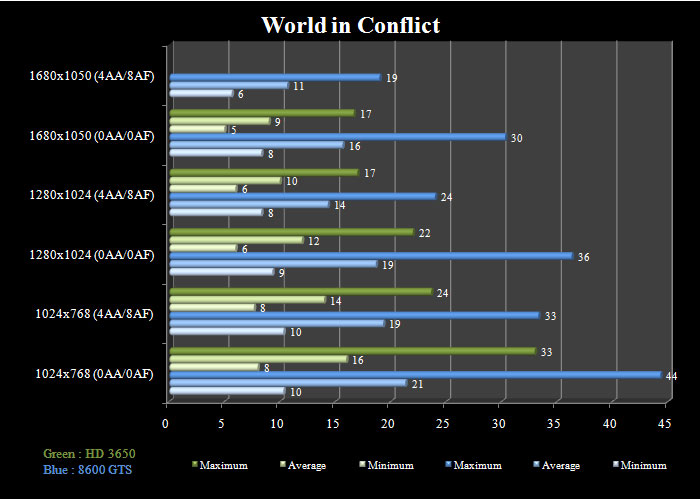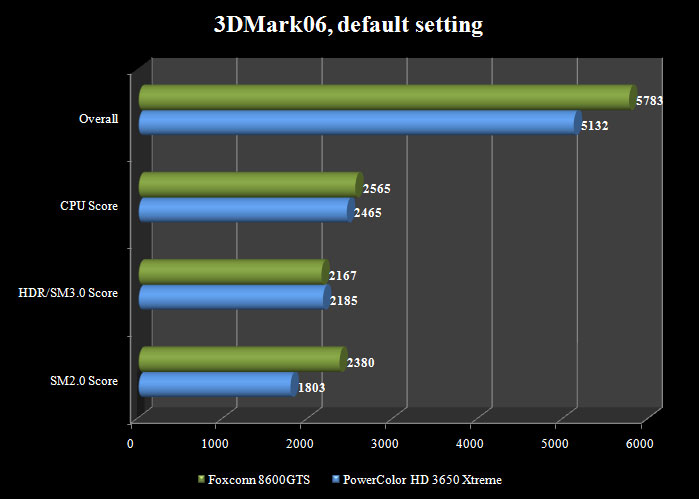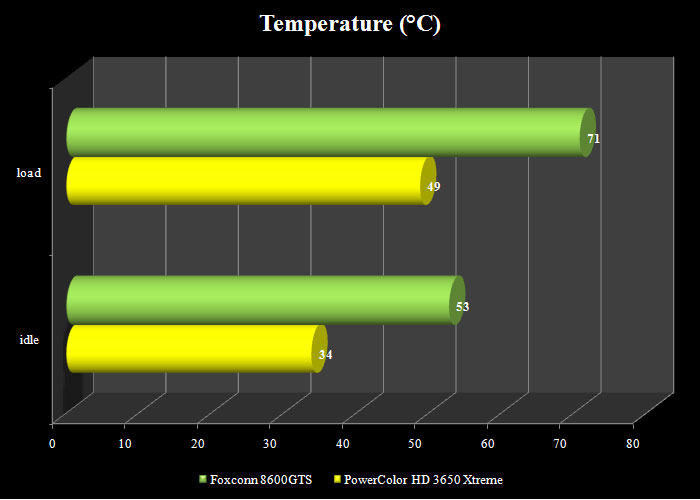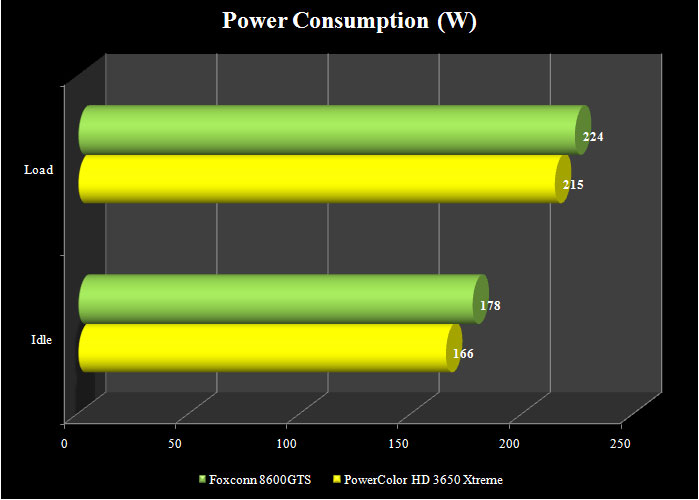AMD has recently released the HD 3000 series cards. The cards are ranging from top of the line HD 3800 for gamers, HD 3600 for mainstream/budger users, and HD 3400 for value users. Today, join us as we are going to take a look at HD 3650 Xtreme from PowerColor. This card carries factory overclock and comes with modification from reference design. Let’s see how well it performs.
INTRODUCTION
Over the last few months, NVIDIA has been enjoying the high-end graphic card market with their current 8800 series. AMD was unable to compete with NVIDIA with their HD 2900 series but the situation is getting better with the introduction of the HD 3800 series. Although AMD is still not able to take the performance crown away from NVIDIA, its latest HD 3850 is performing fairly close and their upcoming card may very well steal the crown away from NVIDIA.
Although AMD was unable to compete with NVIDIA in the enthusiasts market, it is able to compete very well with NVIDIA in the mainstream and budget market. Their latest technology in the HD 3850 has been ported to the mainstream and budget market with the introduction of the HD 3650 and HD 3400 in January 23, 2008 . Today, join us for our first review of the HD3650 as we will take a look at the HD 3650 Xtreme from PowerColor.
POWERCOLOR
PowerColor, established by Tul Corporation in 1997, is a graphics industry leading brand name now and well known for its outstanding performance and innovative technology. As a leading provider of graphics card, PowerColor offers powerful, reliable and cost-effective solutions to customers worldwide.
PowerColor spirit:
Unleash the Gaming Power
PowerColor is the platform of choice for avid PC gamers and video prosumers looking to get the best possible performance out of the latest graphics processors from ATI.
Stunning Performance
PowerColor graphics cards deliver every-last-drop of super-charged performance from ATI’s most advanced visual processing units (VPU). Running a PowerColor graphics card, today’s gamers are able to unleash the 3D graphics performance of their favorite game playing it the way it was meant to be played.
Reputable Product
PowerColor graphics cards won at least 10 awards every month in 2004 from the world’s most respected IT media and organizations. Furthermore, several PowerColor products also received 2005 Taiwan Symbol of Excellence Award from the Ministry of Economic Affairs of the R.O.C. according to the following criteria: Design and Innovation, Quality System, Market, and Brand Awareness. This award represents some of the most revolutionary, high tech, high quality, and high value products in the market.
Market-Oriented Innovation
The right products, the right time, and the best quality is the basic of our product strategy. To put our products one step ahead of the rest, we analyze the trends of the industry, and study the requirement of the market. Meeting the market’s requirement is the core of our branding strategy and our customers’ opinions are always the most important part of this process.
Extensive Service
To keep abreast of the global market and offer our customers the best service, speediest product delivery, as well as sales and technical support, PowerColor has established subsidiaries in mainland China, Taiwan, the U.S.A., and the Netherlands, to strive for best value in the marketing and sales of PowerColor Products.
THE HARDWARE
I will not repeat the nitty gritty detail about the HD 3650. Rather, I will simply direct you to Bjorn3D’s artilcle on the HD 3650 (https://bjorn3d.com/read.php?cID=1221). I do want to highlight a few technologies with the HD 3650. This card uses the RV635 core manufactured with TSMC’s 55nm processes and features 725MHz engine clock, 120 stream processors or 24 five-way superscalar shader units, and a 128-bit memory interface. There are eight texture units and four raster operators (or ROPs). The card now supports ATI PowerPlay technology, DirecX 10.1, and PCI-Express 2.0.
Now, the HD 3650 has a very confusing naming scheme. Since AMD has decided to drop the letter extension for their graphic cards (XT, Pro) and simply uses numbers to indicate the class, you will now find that depending on the HD 3650 the clockspeeds can differ (before overclocking). All of the HD 3650 will have the same engine clock of 725. However, the amount of memory, type of memory, and memory speed can differ. So be sure to watch out when you purchase your card.
PowerColor carries four different types of HD 3650. The HD 3650 Xtreme that we are reviewing today has the highest clocks speed which PowerColor offers. It is clocked at 800Mzh engine clock (as oppose to 725MHz on the reference card) and 900MHz memory clock (as oppose to 800MHz on the reference card). In addition to the HD 3650 Xtreme, PowerColor also has three different models of HD 3650: HD 3650 512M GDDR3 PCS (725MHz engine clock and 800Hz memory clock with 512MB GDDR3), HD 3650 512M DDR2 (725MHz engine clock and 400MHz memory clock with 512MB DDR2), and HD 3650 512M DDR2 SCS3 (725MHz engine clock and 400MHz memory clock with 512MB DDR2). The HD 3650 512M DDR2 SCS3 also comes with silent heatpipes, a good choice for the users who prefer to have a silent system.

The PowerColor HD 3650 comes in a rather small package that is filled with marketing information on the back. On the front, you will see an eye-catching image. Inside the box, you will find another cardboard box that is protecting the cards and its components during shipping.
Our HD 3650 Xtreme is surprisingly small with only 17cm in length. The Xtreme lines from PowerColor comes with their own cooler that should offer a slightly better cooling than the stock AMD cooler. We do not have the reference card with stock AMD cooler so we cannot really compare the temperature difference. The cooler is 90mm in diameter with 65mm fan that pretty much takes up the whole front of the card.
In addition to the modified cooler, the PowerColor HD 3650 also differ from AMD’s reference design of 256MB of GDDR3 RAM clocked at 800MHz. Instead it has equipped the card with 512MB of GDDR3 clocked at 900MHz. The memory that is used is Samsung K4J52324QE-BJ1A, which a quick search online reveals a maximum frequency of 1000MHz. So there is some headroom left for overclocking. The memory interface is 128bit.
There are two DVI connectors and a S-video connector on the back of the card. Personally I would prefer to see either an HDMI or even a DisplayPort on the back but you cannot really complain too much as most cards selling at the similar price range is equipped with only one DVI and one VGA.
As far as the accessories goes, you cannot expect much from a budget card like this. The card only comes with one DVI to VGA adapter, and S-video to composite adapter, driver CD, and a quick installation guide. Despite the fact that no game is included, PowerColor does include CyberLink PowerDVD IClone2 SEI personally would prefer to have a DVI to HDMI adapter to be included as well given to the fact that users who purchase the card will be most likely not going to be hardcore gamers and having the adapter can help users who bought the card for HTPC purpose.
On the top of the card you will see two metal connectors designed for crossfire.
SPECIFICATIONS
|
Graphics Engine
|
RADEON HD3650
|
|
Video Memory
|
512MB GDDR3
|
|
Engine Clock
|
800MHz
|
|
Memory Clock
|
900MHz
|
|
Memory Interface
|
128bit
|
|
DirectX Support
|
10.1
|
|
Bus Standard
|
PCIE 2.0
|
|
Video Input
|
|
|
VGA Output
|
Yes, By DVI to VGA Adapter
|
|
HDTV Output
|
Yes, By HDTV cable
|
|
TV Output
|
Yes
|
|
DVI Output
|
DVI X 2
|
|
Dual DVI Output
|
Yes
|
|
HDMI Support
|
Yes, By DVI to HDMI Adapter
|
|
HDCP Support
|
Yes
|
|
Adapter/Cable Bundled
|
Manual、S-Video to AV cable、DVI to CRT Dongle、DVI to HDMI Adapter、CrossFire cable
|
|
Software Bundled
|
Driver, CyperLink PowerDVD IClone2 SE
|
* All specifications are subject to change without notice. Please check with your supplier for exact offers. Products may not be available in all markets.
TEST CONFIGURATION
|
Test Platform |
|
|
Processor |
Intel E6600 Core 2 Duo at 2.4GHz and OC’d to 3.15 |
|
Motherboard |
EVGA 680i (BIOS P30) |
|
Memory |
Super Talent 4GB (2 x 2GB) 240-Pin DDR2 SDRAM DDR2 800 (PC2 6400) |
|
Drive(s) |
Western Digital Caviar SE16 250GB (WD2500KS-00MJB0) |
|
Graphics |
PowerColor HD3650 Xtreme 512mb (Catalyst 8.1) Foxconn 8600GTS 256MB (ForceWare 169.25) |
|
Cooling |
Thermalright SI-128 with Scythe S-FLEX SFF21F |
|
Power Supply |
Enermax Galaxy 850W |
|
Display |
Gateway FPD2485W |
|
Operating System |
Windows Vista Ultimate 64bit |
The benchmark was conducted under Vista Ultimate 64bit. All the settings in the games are either set in high or maximum. The Company of Heroes and World in Conflict was tested with DirectX 10 enabled. Each test was repeated for three times and the average of the scores was obtained. I opted to test the card only at 1024×768, 1280×1024, and 1680×1050 resolution since these are the common resolution which users will be running the cards in games. In addition, cards are tested with 0AA/0AF and 4AA/8AF to see the effect of the AA and AF in the performance.
|
Synthetic Benchmarks & Games |
|
3DMark06 v. 1.10 (Default settings) |
|
Company of Heroes DX10 v.1.71 |
|
F.E.A.R. v 1.08 |
|
World in Conflict DX10 |
RESULTS
F.E.A.R.
Company of Heroes
World in Conflict
Looking at the gaming performance under Vista 64bit, we can see that the HD 3650 Xtreme is able to offer a decent gaming experience with older games and at 1280×1024 with 4xAA/8xAF. However, with newer games that take the advantage of DirectX 10 and have higher demand on the hardware, the card will not be a good choice at resolution higher than 1024×768 unless you turn off most of the graphical settings.
The slightly more expensive 8600GTS do have a better performance compare to the cheaper HD 3650 Xtreme but even with 8600GTS, the recent games are barely playable with Vista’s high demand on the hardware.
The Company of Heroes is particularly interesting as we can see that the HD 3650 Xtreme is actually able to offer a better fps than the 8600GTS. It is possible that the 512MB of RAM on the HD 3650 is helping it to gain the few frame rates compare to the 256MB of RAM found on the 8600GTS.
3DMARK06
Let’s switch to the synthetic benchmark by looking at the industry standard 3DMark06. In 3DMark06, we can see that the HD 3650 Xtreme’s overall score is slower than the 8600GTS. The result is expected as the 8600GTS is more expensive and should, in theory, performs better. Though what is surprising is that the HD 3650 actually performs better than the 8600GTS in the HDR/SM3 test. This may help to attribute to the higher gaming performance we see with the Company of Heroes.
POWER CONSUMPTION AND TEMPERATURE
The temperature of the HD 3650 Xtreme is amazingly cool. Under idle condition, it runs at merely 34°C! While under load, it runs at 49°C. This is much cooler than the 8600GTS is running at idle. I think this is probably one of the coolest running cards on the market at the moment.
As far as noise is concerned, I have to say the card is absolutely quiet. The cooler which PowerColor puts on the card not only keeps it running cool, it is also really quiet. Even under 3D applications, I do not hear the fan spins up. I do wonder would it even be possible if PowerColor is able to design a total silent model of the card while keeping it running at the same temperature. That would be a great card for the HTPC users.
Since the HD 3650 does not require any additional power, we can assume that it is not going to draw a tremendous amount of power from the power supply. At idle, the system consumes 166W and under load, it draws 49W more of power. This is lower than the 8600GTS which consumes 178W at idle and 224W under load. Although both cards draw a similar amount of power at load, the HD 3650 manages to consume 12W less power than the 8600GTS at idle.
OVERCLOCKING
Given the fact that there is no good application to overclock under Vista 64bit, I can only rely on the AMD’s own Overdrive. The PowerColor HD 3650 Xtreme is already overclocked to 800MHz core and 900MHz memory from the standard HD 3650 of 725MHz core and 800MHz memory, we may not be able to push it much further than it already is. We can see that the Overdrive limits the overlocking of the core to 850MHz and limits the memory to 950MHz so we are being limited by the software.
I run the “Auto Tune” to find the optimal setting and the card was able to overclock to 825MHz and 940MHz (core/memory). A little bit of fine-tuning allows me to push the core to 840MHz and the memory to 950MHz without any issue. Above 840MHz, I was not able to run 3DMarks06, so the maximum core speed is most likely being achieved at 840MHz.
I believe that the memory can be pushed even higher due to the fact that the card uses Samsung memory that is rated at 1000MHz. However, without any good tool to overclock, I was not able to see how high it can be achieved.
A small overclocking to 840MHz (core) and 950MHz (memory) yields 231 points on 3DMark06, not too bad i guess.
CONCLUSION
The recent release of the HD 3870 X2 graphic card has brought AMD back into the graphic card competition. The HD 3650, which is the mainstream/budget graphic cards, is an excellent choice for casual gamers or people who are into slightly older games. Despite its lack of the gaming performance, the HD 3650 actually is packed with many advanced features such as DirectX 10, PCI Express 2.0, Unified Video Decoder (UVD), and CrossFire support. This makes it an excellent choice for the HTPC, users who have integrated graphics, or who wish to upgrade their card to use the aero interface under Vista while keeping the cost low.
The PowerColor HD 3650 Xtreme that we have reviewed today is even a better buy than your reference HD 3650. Its factory overclocked speed and modified cooler gives it a better performance than your average HD 3650 while keeping the card running cool and quiet.
If I have to be picky with the HD 3650 Xtreme, it would have be the dual slot cooler. I do appreciate the quietness and coolness but I do also prefer to see a smaller cooler if it can attain the same result. I actually would even prefer to have a silent heat pipe to completely avoid the need for the additional fan. Considering that the card is aimed toward casual gamers and HTPC users, I believe having a smaller cooler that fits into the SFF or even completely silent heatsink would have been a better choice.
PowerColor HD 3650 Xtreme will receive a score of 8.0 (very good) out of 10 and Bjorn3D Seal of Approval for decent performance and the ability to run the card cool and quiet.
Pros:
+ 512MB RAM
+ PCI-E 2.0
+ Runs cool and really quiet
+ Decent performance in games
+ DirectX 10.1/SM 4.1
Cons:
– Dual slot cooler
– Not for hardcore gamers
 Bjorn3D.com Bjorn3d.com – Satisfying Your Daily Tech Cravings Since 1996
Bjorn3D.com Bjorn3d.com – Satisfying Your Daily Tech Cravings Since 1996

















